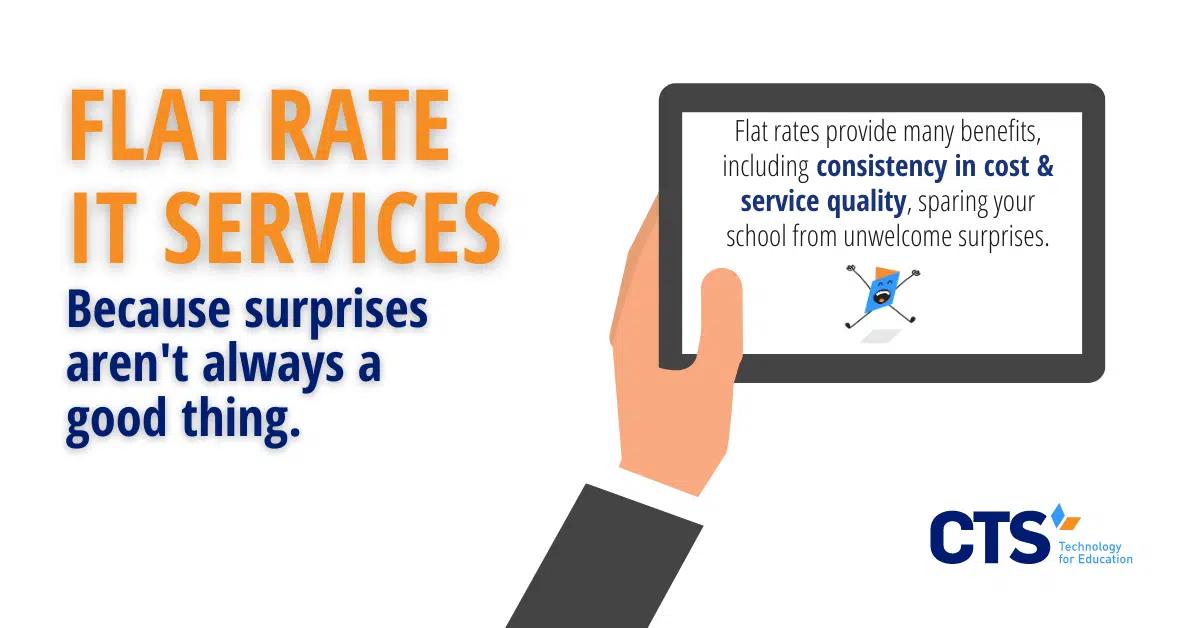Flat-rate IT services offer a “no surprises” solution to volatile technology costs.
Like most organizations, schools perform best under conditions of certainty. Whether it’s the number of teachers they need to hire for the next school year, the number of desks they need to purchase to meet the needs of an expansion, or knowing the ELA or math curriculum they plan to use for the next school year. IT services and technology costs are no different.
Flat-rate IT services allow schools to operate with no surprises. Schools know exactly how much they’ll pay each month, as well as the scope and quality of services they can expect from their provider. Consistency in the IT space allows schools to focus their attention on other priorities that directly support student learning. When a school leader knows how much she’s paying for IT services each month, she can better understand, for example, how much money she can devote to classroom library purchases or to a new curriculum she’s hoping to use for the following school year.
Flat-rate IT services optimize both service quality and overall technology costs.
As part of many flat-rate IT service agreements, schools can expect the service provider to conduct ongoing maintenance and monitoring of the school’s core IT systems. Whether these systems include the school’s wireless infrastructure, such as cabling and WAPs, or hardware like student Chromebooks or staff laptops, under a flat-rate system, the service provider keeps tabs on the most critical aspects of school technology programming.
As a result, schools can avoid otherwise preventable technology issues. Because the IT service firm regularly monitors a network’s switches, for example, the school can largely avoid unplanned service outages or other disruptions that could negatively impact teachers or students. This model makes financial sense as well: rather than paying an exorbitant cost to fix something “on fire,” schools can pay a much lower flat rate that includes ongoing maintenance and repair that preserve the long-term integrity of their technology inventory. Think of the flat-rate system as a safety net. The IT service team identifies preventative maintenance needs so that the school doesn’t have to do so.
Under a flat rate agreement, staying ahead of the curve is part of the provider’s job.
The technology costs associated with flat-rate agreements also buy schools’ expertise. From hallway duty, parent communication, student recruitment, and enrollment, to emergency readiness and transportation, school leaders constantly juggle dozens of competing priorities. The last thing they have time for—generally speaking—is monitoring the latest trends in educational technology.
With a flat rate agreement in place, IT firms draw upon extensive knowledge of the broader educational technology landscape, enabling them to recommend specific software or hardware purchases that will add significant value to school programming. Rather than simply replacing the same software or hardware year-over-year, a school can rely on the flat-rate provider to suggest changes that are either more cost-effective or better support the school’s longer-term instructional needs.
The long-term strategic planning offered by flat-rate providers can ultimately reduce technology costs.
The strategic advice offered under a flat rate system can lower a school’s technology cost in yet another sense. Once they’ve identified schools’ five- or ten-year organizational priorities, the service provider can work with school leadership to optimize year-over-year costs to accomplish these goals. The federal E-rate program is a perfect example.
Once selected to fulfill the school’s E-rate-eligible services, a flat rate IT firm is able to use its knowledge of E-rate best practices to better allocate schools’ limited funds. For example, if a school is planning to add more classrooms and students in the coming years, it may make sense to roll over a specific portion of annual E-rate funds to the following year, helping offset the significant costs associated with more cabling, devices, and WAPs that will likely be needed.
Schools are unlikely to take advantage of such expertise if they use an IT firm on an as-needed basis. Rather than integrating the firm’s members into their technology decision-making processes, the school is more likely to only call upon the firm when something needs fixing. If the agreement between the school and the provider is on an as-needed basis, this may make sense, but it leaves the school without the ongoing expertise a flat-rate agreement can provide.
At CTS, our flat-rate service agreements help clients accomplish their unique missions.
At CTS, our flat-rate service model can help to lower overall technology costs for our school partners, as well as help them make decisions that advance their unique missions. We’ve partnered with more than 60 schools across the United States to make the most of each dollar spent on technology services.
Whether managed IT, educational data, or another aspect of technology programming with which you need assistance, contact us today to learn more about how our team can help your school use technology to accomplish its unique mission.




